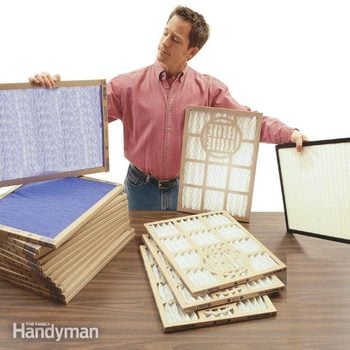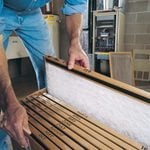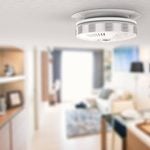Choosing Furnace Filters
Updated: Oct. 26, 2022How to choose the best filter for your furnace

- Time
- Complexity
- Cost
- An hour or less
- Beginner
- Less than $20
How to choose a furnace filter
You may wonder why furnace filter prices have such a wide range, and whether you’ll get your money’s worth from an expensive one. The answer is that you’re getting a filter that requires less changing and captures more, and smaller, particles. The cheap woven fiberglass filters do one thing—screen out dirt and debris that could damage your furnace blower motor, though they do take out some pollen and mold spores. If you can remember to swap them out every month and air quality isn’t an issue, these will do the job.
But if you’re the kind of person who forgets to change the oil in your car, buy a low-priced pleated filter, which require changing only every three months. If you stretched out the accordion-like material in these filters, you’d find two, three or four times the amount of surface area. This means they can capture smaller particles for longer periods of time without impeding the airflow of your furnace.
If members of your household smoke or have allergies or asthma, or if you have pets, look into the more expensive, high-efficiency electrostatic filters—ones that both filter and magnetically attract contaminants. Some are effective for up to a year. They can filter out bacteria, dander, odors and smoke particles. But health experts warn that you may be wasting your money on these filters unless you take the following steps: Use them in conjunction with a high-efficiency vacuum cleaner, install a dedicated air purifier, wash or vacuum the filter monthly and take other steps to clean up your air and house as well.
Keep in mind that filters work harder in summer! So changing furnace filters isn’t only a heating season chore. Many blower motors work at a higher speed in air conditioning mode than in heating mode, meaning you should change filters more often in the summer. A clogged filter can make both your furnace and your air conditioner work harder and less efficiently.
Look for an Efficiency Rating
Many filters carry a MERV (minimum efficiency reporting value) rating, which indicates their effectiveness. The higher the MERV rating, the more effective. Most spun filters have a MERV rating of 4. Standard pleated filters average MERV 6. Electrostatic pleated versions start at MERV 8, with the highest quality ones hitting MERV 12.
Solving the Reduced Airflow Problem
Pleated air filters work great for reducing allergens in your home. But when homeowners leave them in too long, they clog. The reduced airflow causes overheating and burner shutdown. If that happens too many times, the ‘limitswitch’ fails and then the furnace won’t fire up at all. The service call and new part can easily cost you $175
No filter manufacturer can predict how long its filters will last because none of them know the dust conditions in your home So you have to check it often. The rule of thumb is, ‘If it looks dirty, it is dirty.’ If you want a smarter way to determine when it needs replacing, install an air filter gauge. It measures airflow between the filter and the furnace via a small hose.
Required Materials for this Project
Avoid last-minute shopping trips by having all your materials ready ahead of time. Here’s a list.
- Furnace filter



